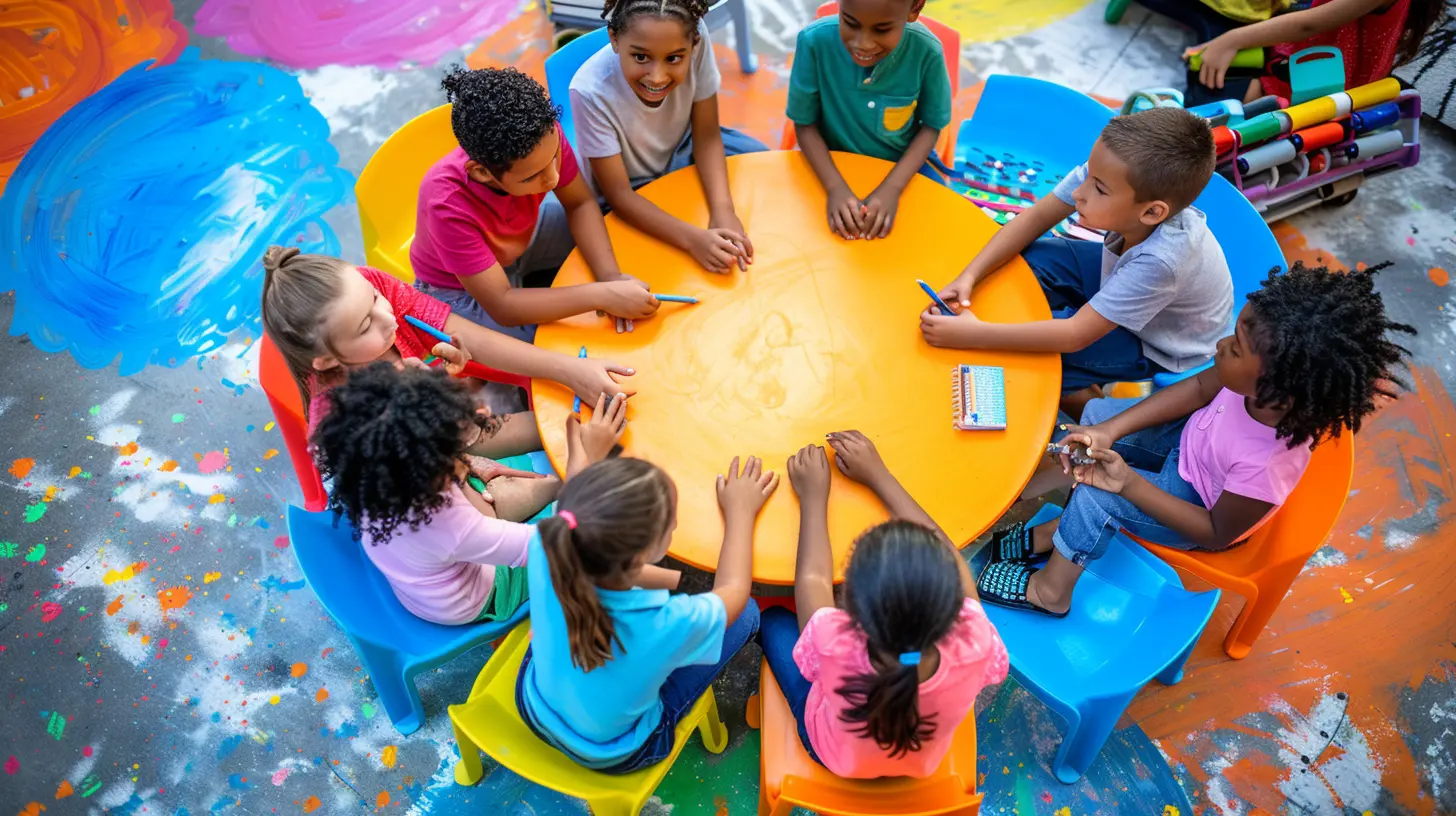Collaborative Teaching Strategies to Inspire Student Engagement
6 January 2025
In today’s ever-evolving educational landscape, one thing is clear: students learn best when they are actively involved in the process. Gone are the days when a teacher stood at the front of the classroom, lecturing as students passively absorbed information like sponges. Nowadays, educators are turning to collaborative teaching strategies to help inspire student engagement. But what does that look like in practice, and why does it work?
Let’s dive into the world of collaborative teaching strategies and explore some effective methods that can turn a dull classroom into a dynamic, interactive learning environment. Trust me; it’s like transforming a quiet library into a buzzing café filled with meaningful conversations. Ready to dig in? Let’s go!

What is Collaborative Teaching?
Before we get into the how, it’s important to understand the what. So, what exactly is collaborative teaching?Simply put, collaborative teaching is when two or more educators work together to plan, teach, and assess students. It’s a team effort—like co-piloting an airplane. Instead of one teacher shouldering the entire responsibility for a class, teachers share the workload and bring their unique strengths to the table.
This approach allows teachers to combine their expertise, offering students a richer, more diverse learning experience. But the magic happens when this teamwork extends beyond educators and involves students working together, too.

Why Collaborative Teaching Inspires Engagement
So, why is collaboration such a game-changer for student engagement? Let’s break it down.1. Different Perspectives Lead to Deeper Understanding
When students are exposed to multiple viewpoints—whether from different teachers or their peers—they start to see topics from new angles. It’s like looking at a diamond under different lights; each facet offers something unique. This diversity of thought encourages curiosity and deeper understanding.
2. Active Participation = Active Learning
Have you ever noticed how much more you remember from a conversation than from a monologue? That’s because discussion fosters active participation. When students collaborate, they’re not just passively receiving information—they’re engaging with it, questioning it, and building on it.
3. It Builds Social and Communication Skills
Let’s be real: life isn’t a solo sport. Whether in school or the workplace, collaboration is key. In a collaborative classroom, students learn how to communicate their ideas, listen to others, and work as part of a team. These are essential life skills, and they also make learning far more engaging.
4. Shared Ownership of Learning
When students feel like they have a say in their education, they’re more likely to take it seriously. Collaborative teaching allows students to take ownership of their learning by contributing to discussions, sharing ideas, and working together. This leads to a higher level of investment and motivation.

Key Collaborative Teaching Strategies
Now that we’ve established why collaboration is so effective, let’s explore some practical strategies to incorporate into your teaching. These methods are designed to engage students and foster a positive, collaborative environment.1. Team Teaching
Team teaching is a classic collaborative strategy where two or more teachers work together to deliver a lesson. Think of it like a dynamic duo—Batman and Robin, if you will. Each teacher brings their own strengths, subject expertise, and teaching style to the table.This can be especially engaging for students because it keeps things fresh. If one teacher is more of a lecturer, and the other is more hands-on, students get the best of both worlds. Plus, it allows teachers to model collaboration in real time—showing students how teamwork can lead to better results.
How to Implement:
- Plan lessons together, ensuring each teacher’s strengths are utilized.
- Split the class into smaller groups, with each teacher leading one.
- Offer different activities, so students can learn in different ways (e.g., one teacher leads a discussion, while the other facilitates a hands-on project).
2. Peer Learning
Peer learning is exactly what it sounds like—students learning from each other. This strategy encourages students to teach, discuss, and work through problems together. It’s like giving them the keys to the car and letting them drive (with you as the co-pilot, of course).When students explain concepts to their peers, it reinforces their own understanding. Plus, they might even explain things in a way that makes more sense to their classmates. After all, sometimes it’s easier to relate to someone who’s in the same boat as you.
How to Implement:
- Use “think-pair-share” activities, where students first think about a problem, then discuss it with a partner, and finally share with the class.
- Create peer tutoring opportunities, where students who excel in a subject can help those who are struggling.
- Encourage group problem-solving activities, like working on math puzzles or science experiments together.
3. Jigsaw Method
The Jigsaw Method is a tried-and-true collaborative strategy that divides a lesson into segments. Each group of students is responsible for mastering one segment and then teaching it to the rest of the class. It’s like putting together a puzzle—each student holds a crucial piece of information that, when combined with others, creates the full picture.This strategy not only promotes collaboration but also encourages accountability. Students know they need to master their section because their peers are counting on them to share that knowledge.
How to Implement:
- Divide the class into groups and assign each group a different aspect of the lesson.
- Have students research or work on their assigned topic.
- Bring the groups together, and let each group “teach” their segment to the others.
- Facilitate a class discussion to tie everything together.
4. Collaborative Projects
There’s nothing like a good old-fashioned group project to promote collaboration. But instead of the dreaded “one person does all the work while the others slack off,” let’s talk about strategic, well-organized projects that truly engage every student.Collaborative projects can range from a group research paper to creating a class blog or podcast. The key is to assign roles and responsibilities clearly so that each student feels like they have an important part to play.
How to Implement:
- Choose a project that requires multiple skills (e.g., research, writing, designing, presenting).
- Assign roles based on students’ strengths or let them choose their roles.
- Set clear guidelines and deadlines to keep everyone on track.
- Incorporate regular check-ins to ensure everyone is contributing.
5. Socratic Seminars
Socratic Seminars are like a group discussion on steroids. In this strategy, students engage in a deep, thoughtful conversation about a specific topic, text, or question. The teacher acts as a facilitator, encouraging students to ask questions, challenge each other’s ideas, and build on each other’s thoughts.This method is fantastic for developing critical thinking skills. It also creates an engaging, collaborative atmosphere where students feel comfortable sharing their ideas. And because the seminar is student-led, they take ownership of the discussion.
How to Implement:
- Choose a thought-provoking question or topic for the seminar.
- Encourage students to prepare by reading or researching the topic ahead of time.
- Set ground rules for respectful, open-ended discussion.
- Act as a facilitator, guiding the conversation without dominating it.
6. Learning Stations
If you’re looking for a way to mix things up and keep students engaged, learning stations might be your new best friend. In this strategy, students rotate between different stations, each offering a unique activity or learning experience. Think of it like a buffet of learning opportunities—there’s something for everyone!Learning stations are great for differentiation because they allow students to learn in different ways. Plus, the movement between stations keeps things lively and prevents boredom from setting in.
How to Implement:
- Set up different stations around the classroom, each focusing on a different aspect of the lesson (e.g., reading, writing, hands-on activity, discussion).
- Divide students into small groups and rotate them through the stations.
- Provide clear instructions at each station to keep students on track.
- Allow time for reflection or discussion at the end.

Overcoming Challenges in Collaborative Teaching
Of course, no teaching strategy is without its challenges. Collaborative teaching requires careful planning, strong communication, and a willingness to adapt. But with a little preparation, these challenges can be overcome.1. Time Management
Collaboration takes time—both for teachers and students. It’s important to plan your lessons carefully to ensure there’s enough time for meaningful collaboration. Set clear expectations and guidelines to keep things moving smoothly.
2. Balancing Group Dynamics
Not all students are natural collaborators, and group work can sometimes lead to conflict or unequal participation. As a teacher, it’s important to monitor group dynamics and intervene if necessary. Encourage students to communicate openly and assign roles to ensure everyone is contributing.
3. Teacher Collaboration
If you’re co-teaching, it’s essential to maintain open communication with your teaching partner. Plan lessons together, share feedback, and be flexible. Remember, you’re modeling collaboration for your students, so it’s important to practice what you preach.
Conclusion
Collaborative teaching strategies are a powerful tool for inspiring student engagement. By fostering collaboration between teachers and students, we create a learning environment where everyone feels valued, heard, and invested in their education. Whether through team teaching, peer learning, or the Jigsaw Method, collaboration allows students to take an active role in their learning, building critical skills for the future.So, the next time you find yourself standing in front of a group of disengaged students, consider shaking things up with some collaborative strategies. It might just be the spark you need to reignite their passion for learning!
all images in this post were generated using AI tools
Category:
CollaborationAuthor:

Fiona McFarlin
Discussion
rate this article
18 comments
Uma McKee
Collaborative teaching ignites a spark of creativity and connection in the classroom! By embracing diverse perspectives and teamwork, we empower students to actively participate in their learning journey. Let’s inspire curiosity and foster a love for knowledge, making education a shared adventure that nurtures lifelong learners. Keep inspiring! 🌟
February 16, 2025 at 1:02 PM

Fiona McFarlin
Thank you! I'm glad you see the value in collaborative teaching. Together, we can truly inspire and empower our students to thrive! 🌟
Fenn Simon
Empowering students through collaboration sparks creativity and fosters a vibrant learning environment. Let's inspire each other to reach new heights!
February 1, 2025 at 9:20 PM

Fiona McFarlin
Absolutely! Collaboration truly enhances creativity and engagement. Together, we can create an inspiring learning atmosphere!
Juno Griffin
This article effectively highlights the importance of collaborative teaching in fostering student engagement. By promoting teamwork, educators can create a more inclusive and dynamic learning environment.
January 28, 2025 at 3:49 AM

Fiona McFarlin
Thank you for your insightful comment! I'm glad you found the article's emphasis on collaborative teaching and its impact on student engagement valuable.
Scarlett McAllister
Together we spark curiosity’s flame.
January 23, 2025 at 4:32 AM

Fiona McFarlin
Absolutely! Collaboration ignites curiosity and fosters deeper engagement in learning.
Azriel McEvoy
This article offers valuable insights into collaborative teaching strategies that effectively enhance student engagement. Implementing these approaches can foster a more interactive and inclusive learning environment for all students.
January 19, 2025 at 3:50 AM

Fiona McFarlin
Thank you for your feedback! I'm glad you found the insights on collaborative teaching strategies valuable for enhancing student engagement.
Sara McClary
Intriguing insights! I'm curious about specific collaborative strategies that have proven most effective in boosting student engagement across diverse learning environments.
January 16, 2025 at 3:50 AM

Fiona McFarlin
Thank you! Effective strategies include cooperative learning groups, peer teaching, and project-based learning, all of which promote active participation and cater to varied learning styles.
Winter Allen
Collaborative teaching is like a team sport for learning! When educators and students team up, the classroom transforms into a lively playground of ideas. Let the teamwork spark creativity and inspire those curious minds!
January 14, 2025 at 7:57 PM

Fiona McFarlin
Absolutely! Collaborative teaching truly enhances the learning experience, turning classrooms into dynamic spaces where creativity and curiosity thrive. Thank you for highlighting its impact!
Mariana Duke
Collaborative teaching transforms classrooms into dynamic learning ecosystems, where diverse perspectives ignite curiosity and foster deeper connections, ultimately inspiring students to take ownership of their education.
January 14, 2025 at 3:35 AM

Fiona McFarlin
Thank you for your insightful comment! I completely agree—collaborative teaching indeed cultivates an engaging environment that empowers students and enhances their learning experience.
Roxanne McIntosh
Great insights! Collaborative teaching not only fosters engagement but also builds essential teamwork skills. By creating an inclusive environment, we empower students to express themselves and learn from one another. Let's inspire a generation of enthusiastic, collaborative learners!
January 13, 2025 at 9:44 PM

Fiona McFarlin
Thank you! I completely agree—collaborative teaching truly enhances student engagement and fosters an inclusive learning environment. Let's continue to inspire our students together!
Zareth McKeehan
Engaging students through collaborative teaching fosters critical thinking, enhances communication skills, and builds community.
January 13, 2025 at 3:21 AM

Fiona McFarlin
Thank you for highlighting these key benefits! Collaborative teaching truly empowers students and fosters a vibrant learning environment.
Vito Rivera
Collaborative teaching isn’t just a trend; it’s the secret sauce for sparking student engagement. Let’s ditch the solo act and embrace teamwork!
January 12, 2025 at 11:36 AM

Fiona McFarlin
Absolutely! Collaborative teaching fosters creativity and connection, enhancing student engagement and learning outcomes. Let's keep the focus on teamwork!
Stephanie Bellamy
This article offers invaluable insights into collaborative teaching strategies that truly resonate. I appreciate the emphasis on fostering student engagement through teamwork and creativity. It's inspiring to see practical techniques that can be applied in the classroom, encouraging a more inclusive and interactive learning environment for all students. Thank you!
January 11, 2025 at 9:45 PM

Fiona McFarlin
Thank you for your thoughtful feedback! I'm glad you found the strategies valuable for fostering engagement and inclusivity in the classroom.
Katalina McCoy
Great insights on engaging students! Collaborating truly enhances the learning experience and fosters deeper connections.
January 11, 2025 at 1:38 PM

Fiona McFarlin
Thank you! I’m glad you found the insights valuable. Collaboration really does enhance engagement and connection in the learning process.
Callisto Vaughn
This article offers practical and innovative collaborative teaching methods that genuinely enhance student engagement. Implementing these strategies can create a more dynamic and interactive learning environment for everyone involved.
January 11, 2025 at 4:40 AM

Fiona McFarlin
Thank you for your positive feedback! I'm glad you found the collaborative teaching methods impactful for enhancing student engagement.
Eloise McAdams
Collaborative teaching strategies not only foster student engagement but also enhance critical thinking and communication skills. By incorporating peer feedback and group projects, educators can create a dynamic learning environment that inspires all students.
January 9, 2025 at 8:38 PM

Fiona McFarlin
Thank you for your insightful comment! I completely agree—collaborative teaching not only boosts engagement but also cultivates essential skills that prepare students for real-world challenges.
Cash Erickson
This article offers valuable insights into collaborative teaching, highlighting how teamwork among educators can enhance student engagement. Emphasizing diverse strategies fosters a richer learning environment, ultimately empowering students to take an active role in their education.
January 8, 2025 at 11:35 AM

Fiona McFarlin
Thank you for your insightful comment! I'm glad you found the article's focus on teamwork and diverse strategies valuable for enhancing student engagement.
Lyra Russell
In the tapestry of learning, collaboration weaves bright threads; together, we ignite minds and hearts, guiding students to dance in the rhythm of shared discovery.
January 8, 2025 at 4:54 AM

Fiona McFarlin
Thank you for beautifully capturing the essence of collaboration in education! Together, we truly can inspire and empower our students.
Nora McAndrews
Empower, engage, excel together!
January 6, 2025 at 7:51 PM

Fiona McFarlin
Thank you! Together, we can create an inspiring learning environment that truly empowers our students.
MORE POSTS

How to Approach Homework Assignments with a Growth Mindset

Blended Learning and the Shift Toward Competency-Based Education

How Civic Education Encourages Lifelong Learning and Civic Engagement

Strategies for Managing Homework in Multiple Subjects

How to Integrate Social-Emotional Learning in Summative Assessments

How to Choose the Best Destination for Your Student Exchange

Why Student Exchange Programs Are Essential in Today’s Globalized World

How to Foster Collaboration in a Blended Learning Classroom

Strategies for Fostering Effective Group Collaboration in the Classroom

Exploring History Through Homeschooling: Engaging Ideas

The Magic of Static Electricity: Easy Experiments with Shocking Results